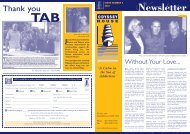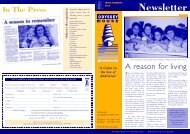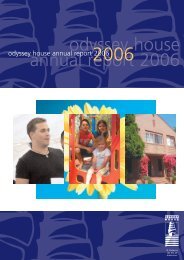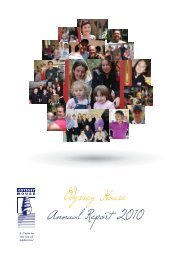ATS Literature Review, Consultations & Trial - Odyssey House
ATS Literature Review, Consultations & Trial - Odyssey House
ATS Literature Review, Consultations & Trial - Odyssey House
Create successful ePaper yourself
Turn your PDF publications into a flip-book with our unique Google optimized e-Paper software.
Amphetamine‐Type Stimulants: Development of a Treatment Protocol<br />
intervention treatment sessions significantly increased their likelihood of remaining abstinent from<br />
amphetamine use over time.<br />
Recommendations from this study include a stepped‐care approach, with the first stage the<br />
provision of a structured assessment of amphetamine use and related problems; self‐help material;<br />
and regular monitoring of amphetamine use and related harms. This would be followed by a brief<br />
intervention, comprising either two or four sessions of CBT, depending on the person’s severity of<br />
use and associated issues, including levels of depression.<br />
In Australia, the current ‘gold standard’ of treatment for methamphetamine use and dependency is<br />
a brief psychological intervention, developed and tested in Australia (Baker, Kay‐Lambkin, Lee, et.al.,<br />
2003). This is a two or four‐session combination of motivational interviewing and CBT, which was<br />
found to significantly increase abstinence amongst dependent methamphetamine users. At six‐<br />
month follow‐up, close to half (49.4%) the treatment group were abstinent, compared to only 27.1%<br />
of the control group who received only the self‐help information in booklet form.<br />
Participants in the study were 282 people, screened to take part between October 2001 and<br />
September 2002. Of these, 214 regular (at least weekly) users of amphetamines were randomly<br />
assigned to either an active intervention (two or four sessions of CBT in addition to a self‐help<br />
booklet) or control condition (self‐help booklet only). The self‐help booklet was developed by<br />
NDARC in 2001.<br />
The CBT intervention focused on developing skills to reduce amphetamine use. Four sessions were<br />
conducted individually and lasted 45‐60 minutes. In the two‐session intervention, the procedure<br />
and content was the same as that for the four hour intervention (Baker, et.al., 2003). At pre‐<br />
intervention, subjects were a group of regular amphetamine users with long using histories, high<br />
dependence, injecting risk taking behaviour, polydrug use, depression, psychiatric illness and poor<br />
quality of life (Baker, et.al., 2003).<br />
In this study all groups, including the no‐treatment group, significantly reduced their substance use<br />
(Jenkinson, et.al., 2008). However, being in the intervention group was significantly associated with<br />
abstinence, which implies active therapy gave subjects an added incentive for abstinence.<br />
The brief treatment intervention, developed as a result of this research, is based on the assumption<br />
of the motivational enhancement therapy (MET) approach, which maintains that responsibility for<br />
change lies within the client (Miller, Zweben, DiClemente & Rychtarik, 1995). Under this model, the<br />
role of the therapist is to enhance the client’s own motivation and commitment for change through<br />
the five basic motivational principles of:<br />
1. Express empathy;<br />
2. Develop discrepancy;<br />
3. Avoid argumentation;<br />
4. Roll with resistance; and<br />
5. Support self‐efficacy.<br />
The main goal of the intervention is to reduce the level of drug use and harm, including mental and<br />
physical health, financial, social and occupational harms (Baker, et.al., 2003). The manualised<br />
approach provides guidelines for the delivery of sessions, including activities, worksheets and<br />
homework tasks.<br />
Page 46 © Lynne Magor‐Blatch & James A. Pitts: <strong>Odyssey</strong> <strong>House</strong> McGrath Foundation 2008‐2009








